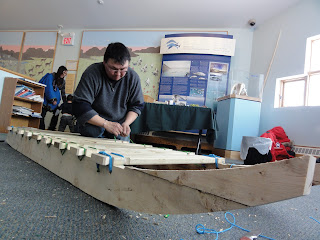On Saturday we attended a qamutiq building workshop. Traditionaly qamutik were made from frozen fish or caribou leg bones wrapped in caribou skin to form planks which were then lashed together with strips of sealskin, this one was made of wood and rope.
In a modern day qamutiq the runners are made from lengths of 1 x 4 with the curved front points created by cutting a curved section from the the bottom of the wood, then attaching the removed portion to the top. Regional variations have developed, including rounded tips but essentially the height and angle of the qamuitq's prow are dictated by the hunter's personal preference and the geographical conditions it is to be used in. This style is a good multi purpose qamutiq suitable for the lower Baffin region.
The slats are shaped carefully to accommodate the rope that holds that qamutiq together. Sharp edges are created when cutting the slats to the template, these must be pared to a smooth curve so that the rope does not get cut over time. In this style of qamutiq the front and back slats have one straight and one curved edge, the straight edges facing the front and back respectively. All the interior slats are curved on both sides to an extended oval shape.
The front and back slats are attached first. These two slats are fastened independently wheras the remainder are secured by a single length of rope. Again the wood around the drilled hoes is pared away to eliminate chaffing that would eventually cut through the rope. there is a specific technique for running and fastening the rope at each slat, I did not attain a good enough understanding to be able to explain this technique, but I did video it so that we can watch and learn. In this picture Dino is supervising Jan as he practices the technique, an important lesson as he just took delivery of a qamutiq from Dino and plans to take it out hunting soon. you want to be able to make your own repairs when you are out on the ice, there is no BCAA.
To complete the qamutiq, teflon is attached to the base of the runners and metal stips over the prows to protect them from the ice.




No comments:
Post a Comment